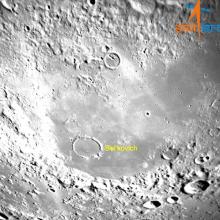Listen to today's episode of StarDate on the web the same day it airs in high-quality streaming audio without any extra ads or announcements. Choose a $8 one-month pass, or listen every day for a year for just $30.
You are here
Moon, Venus, Jupiter III
The three brightest objects in the night sky line up as night falls. The planets Jupiter and Venus are below the Moon, in that order. Nothing else is anywhere close to their brightness, so you can’t miss them.
The Moon is the last of the three bodies to set, about 9:30 or 10. We won’t see it again until sunset tomorrow. If you just can’t wait that long, though, you can see bits of the Moon at more than 40 locations across the United States.
Those bits are from the Apollo missions. Astronauts collected almost 850 pounds of lunar samples. Hundreds of scientists around the world have studied the collection of rocks and dirt. Most of the remaining samples are stored in a lab at Johnson Space Center in Houston, where they’re still shipped out for study — and probably will be for decades to come.
But NASA has sent out many samples for public display. Most of them came from the final three Apollo missions. Most of the display samples are tiny — not more than a few grams.
They’re on display at NASA visitor centers, presidential libraries, and Smithsonian museums. Others are at state science and history museums, or at big aviation museums. According to NASA, they can be found in 23 states — from Massachusetts to California, Florida to Hawaii, plus Washington, D.C.
And if you’re outside the U.S., you’re not shut out: Lunar samples are on display in almost a dozen other countries.
Script by Damond Benningfield





